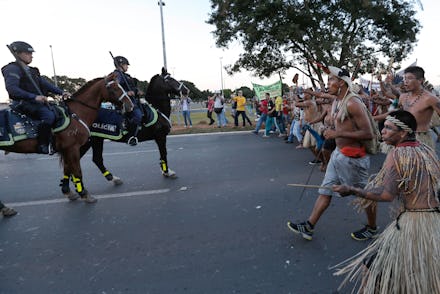Why the World Cup Will Be Bad News for Indigenous People

Clad in traditional clothes and armed with bows, arrows, and spears, hundreds of people from Brazil's indigenous communities defended their territorial rights. They clashed with government security forces, who rode horses and carried much more advanced weaponry.
You would be forgiven for assuming this scene transpired 500 years ago, when in fact it happened Wednesday in Brazil's capital, Brasília. One policeman was shot in the leg with an arrow, while security forces fired tear gas to disperse the crowd.
The reason for the clashes? The upcoming World Cup.
Image Credit: AP
At first blush, the World Cup wouldn't seem to have much to do with indigenous communities. But Brazil's indigenous population, which encompasses some 300 different languages and ethnicities, has found a common cause in the denunciation of the Cup.
Many of the issues that Brazil's poor favela residents face ahead of the mega event — land insecurity, government neglect and unpunished violence — also bedevil their indigenous counterparts. Indeed, the group that clashed with police in Brasília had participated in a protest earlier that day over federal proposals to demarcate indigenous land. They then decided to join forces with the anti-Cup protests afterward.
Image Credit: AP
This wasn't the first time that conflict arising over the World Cup and indigenous rights had led to violence. Last year, next to the Maracanã stadium in Rio de Janeiro, police forcibly evicted informal residents of the abandoned Brazil Indian Museum. Housing between 10 and 20 different ethnicities, the communal residence had become something of an anthropological oddity, allowing indigenous families to live in the heart of one of South America's largest cities.
"Indigenous men and supporters sleep on hammocks inside the abandoned old Indian museum in Rio de Janeiro, Brazil." Image Credit: AP
After negotiating with the government, the residents had agreed to leave the compound and were in the process of vacating the premises, but the police stormed it anyway. The evictions were, ostensibly, to make room for a stadium parking lot, though FIFA has distanced itself from those claims. The episode became a flash point for opponents of the Cup, gathering students, activists and even FEMEN, a feminist protest group.
Preparations for the World Cup have shone a spotlight on the problems afflicting Brazil's cities. Poor families lacking formal land titles face evictions that make way for projects that benefit developers. Police brutality against favela residents is all too common. But this attention on issues related to socioeconomic class, though certainly merited, has overshadowed the parallel effects that development projects and violence have had on indigenous communities.
Brazil has one of the highest numbers of conflicts over environmental issues, according to the Environmental Justice Atlas. Indian communities are particularly concerned over the rich hydroelectric potential of the Amazon Basin and have fiercely protested the construction of potentially disruptive new dams. They denounce what they see as land grabs by the industrial farmers profiting from Brazil's agricultural boom. These conflicts have been deadly. More than 500 indigenous persons were killed over the past decade, and of the 1,000 murders of environmental activists since 2002, roughly half have occurred in Brazil.
With the creative and unrelenting efforts of citizens and journalists, it is become more clear that the World Cup has drawn attention to problems that Brazil can't ignore anymore.